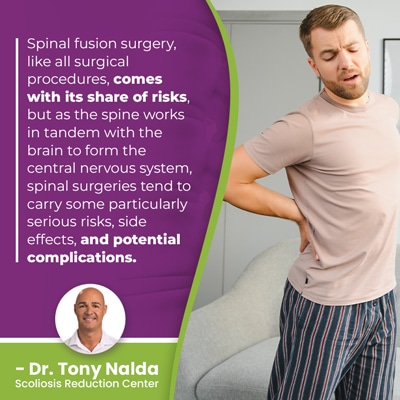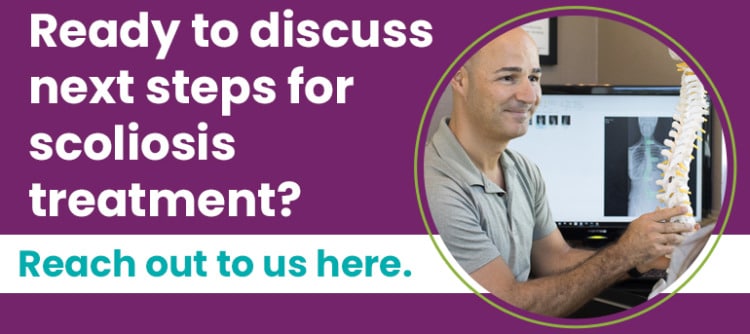Understanding Potential Complications of Scoliosis Surgery

There are different ways to treat scoliosis, and as an ongoing progressive condition, how it responds will shape the spine's future health and can affect a patient's quality of life. Scoliosis surgery involves a type of spinal fusion that comes with some serious potential risks, side effects, and complications.
No two cases of scoliosis are the same. Not only are there different severity levels, there are also different condition types, and the reality is that many cases don't need to face the potential complications of scoliosis surgery which can include nerve damage and increasing spinal rigidity.
What I want scoliosis patients to understand is that there is more than one way to treat scoliosis, and they will shape the spine's future strength and health differently.
Table of Contents
How Scoliosis Changes the Spine
Scoliosis affects the spine, its surroundings, and the entire body in a number of ways, and as a progressive condition triggered by growth, the effects can become more severe and noticeable over time.
Scoliosis causes an unnatural and unhealthy spinal curvature to develop, and this means the condition causes a loss of the spine's healthy curves.
A healthy spine has three main curves in each of the main spinal sections: cervical spine (neck), thoracic spine (middle/upper back), and the lumbar spine (lower back).
Scoliosis doesn't just cause a spinal curve to bend unnaturally to the side, it also rotates, making the condition 3-dimensional.
Scoliosis introduces a lot of uneven forces to the spine, its surrounding muscles, nerves, and the entire body; a spine that's misaligned can cause the body to become misaligned from its head to the feet.
 The goal of conservative scoliosis treatment is to restore balance and stability to the spine and body, manage progression, and help patients avoid the necessity for invasive surgical intervention.
The goal of conservative scoliosis treatment is to restore balance and stability to the spine and body, manage progression, and help patients avoid the necessity for invasive surgical intervention.
Scoliosis Surgery Risks, Side Effects, and Complications
 Spinal fusion surgery, like all surgical procedures, comes with its share of risks, but as the spine works in tandem with the brain to form the central nervous system, spinal surgeries tend to carry some particularly serious risks, side effects, and potential complications.
Spinal fusion surgery, like all surgical procedures, comes with its share of risks, but as the spine works in tandem with the brain to form the central nervous system, spinal surgeries tend to carry some particularly serious risks, side effects, and potential complications.
There are different types of spinal fusion surgery, but the procedure generally involves identifying the curve's most unnaturally tilted vertebrae, removing the discs that sit between adjacent vertebrae to be fused, and fusing the vertebral bodies together into one solid bone; this is done so movement can't occur; movement means progression so the bones can't become more unnaturally tilted over time.
Metal rods are commonly attached to the spine with pedicle screw fixation to maintain the spine's position.
When it comes to accessing the spine, this can be done in different ways, some considered less invasive than others, but generally, small incisions are made next to the spine, through which a camera scope is passed to guide the surgeon.
Muscles and tendons will need to be cut through to assess the area, and the more cutting there is, the lengthier the recovery time.
So let's break down the different risks associated with the procedure itself, followed by potential side effects and complications.
Procedural Risks of Spinal Fusion Surgery
Spinal fusion surgery comes with risks including nerve damage, excessive blood loss, infection, and adverse reaction to hardware used.
If there is a complication during the procedure, this will lengthen both the surgery and the recovery period.
The spine and brain form the central nervous system so facilitate sensation and mobility; nerve damage can mean a loss of communication between the brain and the rest of the body, and radiating nerve pain felt throughout the body.
Side Effects of Spinal Fusion Surgery
Spinal fusion surgery has the goal of stopping scoliosis from getting worse, not correcting it; conservative nonsurgical treatment has corrective treatment results as the goal.
A spine that's fused is going to be more rigid, and this is contrary to the spine's movement-based design; a fused spine can be less flexible and have a reduced range of motion, and this an also mean some patients are unable to continue in certain sports and activities that were safe prior to spinal fusion.
A spine that's fused is fused for life, and if anything goes wrong, the only recourse is more surgery, and the risks of revision surgeries increase with each procedure and increasing patient age.
A spine that's fused will be fused for life, and in addition, fused spines are weaker and more vulnerable to injury.
Potential Complications of Scoliosis Surgery
Every patient responds to treatment in their own way, including surgical treatment, and whether or not there were any complications during the procedure or in the immediate days following is a key factor.
Potential complications during the procedure can include excessive blood loss, nerve damage, and an adverse reaction to the hardware used.
Potential long-term complications can occur if a screw comes loose and/or a metal rod cracks and/or breaks.
In addition, if a person with a fused spine has a car accident, or any type of accident, the spine is way more vulnerable to injury and/or breaks.
There is also the risk of a surgical site infection, and many patients report experiencing an increase in pain at the fusion site.
So a spinal-fusion related complication is likely to lead to a longer recovery time, more time spent in hospital, and potentially more surgery.
Spinal surgeons have their patients' best interests at heart, and while many patients will be pleased with their spinal fusion results, there are also different experiences, particularly in cases that are severe, atypical and involve fusing a larger number of vertebrae.
So what alternative nonsurgical treatment options are out there?
Conservative Scoliosis Treatment
Here at the Scoliosis Reduction Center®, patients are offered a multifaceted treatment approach that works because it can impact conditions on every level.
There are never treatment guarantees, but with early detection and intervention, there are fewer limitations to what treatment can achieve.
Conservative treatment works towards preventing progression and increasing effects, along with the need for invasive surgical treatment.
Nonsurgical Treatment is Chiropractic-Centered
Conservative treatment is nonsurgical and conservative and integrates multiple different types of treatment so conditions can be impacted on every level: correcting the spine's structural abnormality by realigning the spine, applying physical therapy and scoliosis exercises to increase the strength and balance of the spine's surrounding muscles for more spinal support and stability.
Corrective bracing is particularly effective on growing spines because they are more malleable during growth, so bracing is a regular facet of treatment in childhood scoliosis and can help by pushing the spine into a corrective position.
Rehabilitation is the ongoing portion of treatment that can include continued chiropractic care, lifestyle guidance, and custom prescribed home exercises for further healing and stabilizing the spine.
Together, these disciplines complement one another and target the spine's structural misalignment and can improve the spine's surrounding muscle balance and symmetry for more support.
Improving posture through teaching postural awareness can be achieved through custom mirror image exercises; patients are taught how to hold their spines and bodies during exercise, and this awareness can be applied to all daily activities.
A spine that's held in alignment is supported by good posture; chronic poor posture introduces adverse spinal tension to the spine, and over time, this can contribute to spinal degeneration.
A spine that's corrected through conservative treatment has had as much of its natural strength and function as possible preserved.
So there are a number of benefits to nonsurgical treatment that involve the long-term health and function of the spine.
Conclusion
Scoliosis surgery complications aren't common, but they do occur so should be considered carefully.
In addition to the risks associated with the procedure itself - nerve damage, infection, hardware reaction - there are also side effects to consider.
A common effect of living with a fused spine is not being as flexible, and a spine with a reduced range of motion can cause activity restrictions.
A fused spine is also not as strong so it's going to be more easily injured, and the knowledge of this can affect people in different ways. Some become fearful to try new things, while others settle into a more sedentary lifestyle for fear of straining their spine.
Revision surgeries are needed if the fusion is unsuccessful for any reason, and although the procedure's goal is to stop scoliosis from progressing, there is no guarantee that it will succeed.
The more surgery is needed, the more risky they become, and remember, when it comes to the longevity of hardware used in the fusion, the younger a patient is at the time of surgery, the longer the hardware has to last and perform optimally inside the body.
Dr. Tony Nalda
DOCTOR OF CHIROPRACTIC
After receiving an undergraduate degree in psychology and his Doctorate of Chiropractic from Life University, Dr. Nalda settled in Celebration, Florida and proceeded to build one of Central Florida’s most successful chiropractic clinics.
His experience with patients suffering from scoliosis, and the confusion and frustration they faced, led him to seek a specialty in scoliosis care. In 2006 he completed his Intensive Care Certification from CLEAR Institute, a leading scoliosis educational and certification center.
About Dr. Tony Nalda
 Ready to explore scoliosis treatment? Contact Us Now
Ready to explore scoliosis treatment? Contact Us Now





